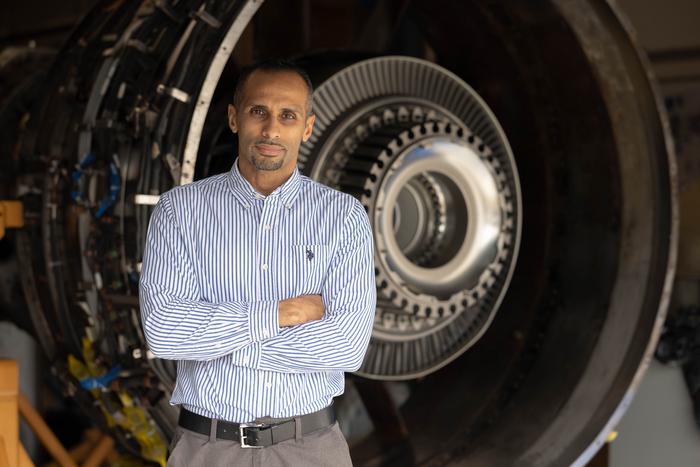ORLANDO, May 6, 2024 – Substantial new funding from the U.S. Department of Defense is helping further establish the University of Central Florida as a leader in hypersonics and space propulsion research not only in the nation, but in the world.

Credit: Photo by Kadeem Stewart, University of Central Florida
ORLANDO, May 6, 2024 – Substantial new funding from the U.S. Department of Defense is helping further establish the University of Central Florida as a leader in hypersonics and space propulsion research not only in the nation, but in the world.
Hypersonic propulsion would allow for air travel at speeds of Mach 6 to 17, or more than 4,600 to 13,000 miles per hour, and has applications in commercial and space travel.
Over the past year, the DoD has awarded funding to hypersonics research led by Mechanical and Aerospace Engineering Professor Kareem Ahmed to support the advancements he’s making in the technology.
The awards are funding the construction of a hypersonic testing facility, flight experiments and further advancements of the technology.
The support is a testament to the progress UCF has made in the field, including developing the first hypersonic rotating detonation rocket engine, which could allow for air travel from New York to L.A in less than 30 minutes. It also comes on the heels of recently received DoD funding to build a morphing hypersonic engine.
“High-hypersonic propulsion technology is being born here, similar to how new technology was developed at Kennedy Space Center during the space era,” Ahmed says. “Now it’s happening at UCF. The new funding highlights that we’re a major player in hypersonic propulsion.”
The most recent projects include:
High-Hypersonic Enthalpy Facility (HiHYPER) for Hypersonic and Space Propulsion
Achieving ultra-high-speed flight at hypersonic speeds is a national priority and an international focus driving the hypersonics and space race. Such systems would allow flight through our atmosphere at very high speeds and allow efficient entry and exit from planetary atmospheres. This will make hypersonic defense systems, space exploration, and intercontinental travel as routine as intercity travel is today.
Advanced hypersonic propulsion systems are needed to maintain the technological superiority of the U.S. Air Force relative to the growing technological threat from adversaries. High-speed propulsion research requires hypersonic facilities that could generate the representative flight Mach numbers and enthalpies.
This project, funded by the U.S. Air Force Office of Scientific Research (AFOSR), aims to develop a unique mid-scale high-hypersonic enthalpy propulsion testing facility at UCF for integrated hypersonic materials, aerodynamics, and propulsion research (HiHYPER). HiHYPER will provide significant new capabilities to explore the fundamentals of the hypersonic regime and overcome the most significant national challenges where advances are needed in hypersonic research.
Hypersonic Flight Experiment for High-Speed Propulsion Detonation Fundamentals
This project’s objective is to develop the experimental hardware for a flight experiment to stabilize and investigate standing oblique detonation waves under an AFOSR program.
The technology offers improved jet propulsion engine efficiency so that more power is generated while using less fuel than traditional propulsion engines, thus lightening the fuel load and reducing costs and emissions.
In addition to faster air travel, the technology could also be used in rockets for space missions to make them lighter by requiring less fuel, travel farther and burn more cleanly.
The flight experiments are critically needed to provide the structure and dynamic details of standing oblique detonation waves in a hypersonic flight regime. The flight experimental results will form the foundation for hypersonic detonation engines.
Distinguished Fellow: Advanced Flow-Independent Fuel Injector for Naval Propulsion
This project, funded by the Office of Naval Research, will explore and document the evolution spray and splash dynamics of the flow independent fuel injector, a type of fuel injector designed to deliver a consistent and precise amount of fuel regardless of variations in fuel pressure.
Fuel control will improve Navy applications system performance that are reliant on jet-in-crossflow fuel injectors commonly used in combustors and augmentors to fuel modern Navy propulsions systems, such as the F35.
These improvements will lead to efficient propulsion and power systems that control jet fueling for enhanced performance. Fuel injection is a critical technology for Navy Aircraft propulsion, unmanned aerial vehicles, ship propulsion and power, ramjets/scramjets and missiles.
Researcher Credentials
Ahmed joined UCF’s Department of Mechanical and Aerospace Engineering, part of UCF’s College of Engineering and Computer Science, in 2014. He is also a faculty member of the Center for Advanced Turbomachinery and Energy Research and the Florida Center for Advanced Aero-Propulsion. He served more than three years as a senior aero/thermo engineer at Pratt & Whitney military engines working on advanced engine programs and technologies. He also served as a faculty member at Old Dominion University and Florida State University. At UCF, he is leading research in propulsion and energy with applications for power generation and gas-turbine engines, propulsion-jet engines, hypersonics and fire safety, as well as research related to supernova science and COVID-19 transmission control. He earned his doctoral degree in mechanical engineering from the State University of New York at Buffalo. He is an American Institute of Aeronautics and Astronautics associate fellow and a U.S. Air Force Research Laboratory and Office of Naval Research faculty fellow.
CONTACT: Robert H. Wells, Office of Research, robert.wells@ucf.edu
Discover more from Science
Subscribe to get the latest posts sent to your email.


